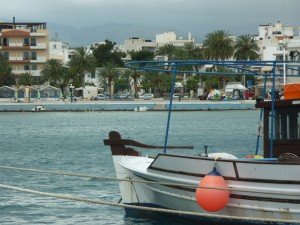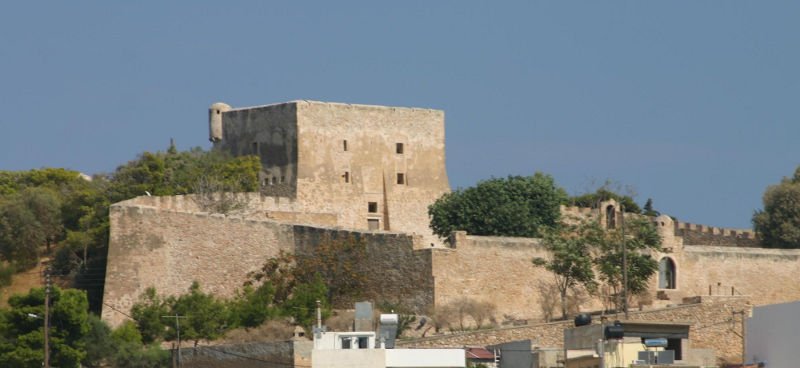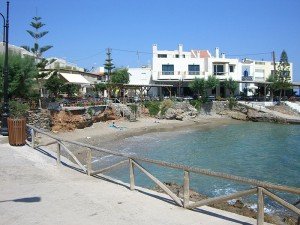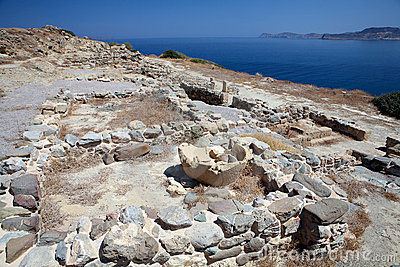The most important sights of Sitia and the surrounding area are:
 The Venetian fort of Kazarma that oversees the city and offers fantastic view. It was attacked numerous times, by pirates, during the 15th and 16th century, but the greatest disaster was caused by the infamous pirate Barbarossa, in 1538. Throughout the Turkish occupation, modifications were made, that are still visible.
The Venetian fort of Kazarma that oversees the city and offers fantastic view. It was attacked numerous times, by pirates, during the 15th and 16th century, but the greatest disaster was caused by the infamous pirate Barbarossa, in 1538. Throughout the Turkish occupation, modifications were made, that are still visible.- The picturesque port of Sitia, with its fisherman boats, the restaurants and the raki-taverns, the palm trees and the monument of the great poet who wrote “Erotokritos”, Vincenzo Cornaros.
- The Sitian archeological museum. Hosting exhibits from the broader area of Sitia, which cover a period of 4 millennia (3.500 BC – 500 AD). Amongst the exhibits, you can find the Kouros of Palecastro and the findings from the MinoancemeteryofAgia Fotia(Sacred Flame).
- The Local Products Exhibition of Sitia. The internationally awarded and acclaimed Sitian oil, the wine, the raki and other unique local products, are exhibited here, under the providence of the Union of Agricultural Cooperatives of Sitia.
- Tripitos. 3 kilometers east of Sitia, on the road to Palecastro, lies Tripitos. A settlement flourished in this location, during the Hellenistic period. Another important finding is the carnagio –where lifting and repairing of ships took place– the only confirmed one in Crete.

- Petras. Across from Sitia, in a distance of 2 kilometers, on a hill that stands out, lies the settlement of Petras. An ideal place to spend your vacation in. There are plenty of rooms to let and small hotels. The beach of Sitia is a hair’s breadth away and the view is outstanding. (you can see the entirety of the sea, Dyonisades, Sitia, the Port, the fields and the river Pantelis). A remarkable archeological site is located at the south side of the hill.
- The historical Toplou Monastery. It hosts a small museum, with nevertheless, remarkable exhibits. It played a very important role in the passing of the ages in the area, until the German occupation, since this is where the monks hid one of the two radios, used by the Greek resistance.

- The Vai Palm Grove. The only palm grove in Europe is located at the northeastern coast of Crete, at the cape Cavo Sideros. It’s 24 kilometers (24 minutes) away from Sitia. It’s a fantastic palm grove, leading to a beautiful sandy beach.
- Itanos (Erimoupoli). A little bit to the north of Vai (5 minutes by car), lies the ancient Itanos or Erimoupoli, as it is known. The ruins of the ancient city are located right next to the marvelous, homonymous beach. The wonder of the location is the seabed, which hosts the sunken (and largest) part of the ancient city of Itanos! The underwater city is visible, while wearing a mask, from the surface and is located really close to the shore.
- Archeological site of Palecastro. The village Palecastro is located 17 kilometers easy of Sitia and is the largest village in the area. The archeological site is located a little ways from the village, in Chiona. It’s a very important post-Minoan settlement, that was destroyed during the 15th century BC, due to a tidal wave that was caused by the eruption of the volcano in Santorini (Thera). The most remarkable finding in the site, is the Holy of Diktaios Dias, the most important one in easternCrete.
- Kato Zacros. The 4th Minoan palace (Knossos, Phaistos and Mallion) that was brought to light with the archeologists’ excavations. It’s the most important archeological site in eastern Crete, in which, 10.000 objects of outstanding Minoan art, were found. The palace survived for merely 150 years! It was built in 1600 BC and destroyed in 1450 BC, with the eruption of the volcano in Santorini (Thera).

- The canyon of the dead, that comprises the end-part of the European trail E4, starts at Pano Zacros and ends at Kato Zacros. It’s a route quite popular to hikers, with a length of 5.5 kilometers and a walk-through time of approximately 2 hours. In the coastal settlement of Kato Zacros, you will find excellent seafood taverns and a beautiful, sandy beach.
- Ancient Pressos. With the Dorian Invasion, the indigenous Eteocretes, were ousted to eastern Crete, where they settled around Pressos. In a distance of 13 kilometers from Itia (today’s Sitia), it (Pressos) was built on three hills-citadels and was a living city, from the Neolithic era, until the Hellenistic era (2nd century BC). The digs revealed important findings (shields, idols, breastplates, etc). Part of the wall that surrounded the citadel, is still standing, along with other buildings.
- Mochlos. 27 kilometers west of Sitia, lies the coastal settlement of Mochlos. A wonderful fisherman-village, ideal for relaxation, calm and rest. Here, you will find excellent taverns right by the sea, important archeological sites and quaint little alleyways, ideal for a walk through the village’s picturesque houses. The advanced tourist infrastructures coexist peacefully with concepts, such as tradition and calm.
- Canyon and Waterfalls of Richti. The beautiful canyon starts at the village Exo Mouliana and ends at the Cretan sea. You can find water springs in numerous locations, which causes the water to flow constantly, through the canyon. Walking through the route, you will come up to a magnificent waterfall, 18 meters tall, a single-arched bridge and two ruined watermills. The forest surrounding the canyon is simply wonderful.

Leave a Reply
You must be logged in to post a comment.